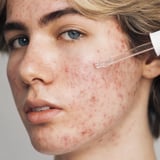We’ve all been there – a red bump or an unsightly blackhead pops up on your face out of nowhere at the most inopportune time. While it’s totally normal, albeit massively annoying, experiencing clogged pores comes with the territory of not only having skin but also having to face the outside elements daily.
Though they may have haunted your teenage years, dealing with continuous pores clogged with hard sebum as an adult can be increasingly frustrating. While the occasional spot is sometimes unavoidable, if you’re finding that you’re struggling with clogged pores more often than not and feeling like you’re at a loss, we’re here to help. Read on to learn how to unclog pores with tips from skin-care professionals.
What Do Clogged Pores Look Like?
Though clogged pores are extremely common and pretty easy to identify, understanding how they actually occur is a different story. Let’s briefly review the nuances of pores and the various ways clogged pores manifest on the skin. “Pores are the tiny openings in our skin through which we release oil and sweat. Clogged pores occur when dead skin cells or excess oil and dirt get trapped in these small crevices,” Dendy Engelman, MD, FACMS, FAAD, a board-certified cosmetic dermatologist and Mohs surgeon, tells PS.
“Pores can become clogged for a number of reasons. Not removing makeup at the end of the day, excessive perspiration, or even simply genetics are all potential factors that could lead to having clogged pores,” says Dr. Engelman. She also adds that depending on the time of year, your skin could be more susceptible to clogged pores. “Since excessive perspiration is a contributing factor to clogged pores, they are more likely to occur during the warmer times of [the] year,” she says.
Once a pore becomes clogged due to any of the aforementioned reasons, it will manifest on the face through “acne, blackheads, and excessive shiness,” says Dr. Engelman. They are not, however, to be mistaken with sebaceous filaments, which tend to look like blackheads but are actually thin and threadlike accumulations that line your sebaceous (or oil) glands. Their purpose is to help move sebum to the surface of the skin, helping to keep the skin hydrated. Sebaceous filaments are not acne but can look like it when the glands overproduce sebum, causing them to appear more noticeable and blackhead-like. They also tend to be more noticeable depending upon the thickness of your hair follicles in the skin, skin-care choices, and your age.
How to Unclog Pores
While clogged pores can be aggravating, luckily, there are numerous ways to treat them. “While it can definitely be frustrating, a consistent skin-care routine, which incorporates double-cleansing, BHAs, and retinol paired with a healthy diet, can make a difference for those who struggle with genetically oily skin,” Dr. Engelman says.
Though you can start with incorporating the proceeding recommendations below, Shelia Farhang, MD, a board-certified dermatologist, cosmetic surgeon, and founder of Avant Dermatology & Aesthetics in Tucson, stresses the importance of visiting your dermatologist if you’re dealing with frequently clogged pores. She likes to assess a patient’s skin type and sensitivity first, as some skin-care ingredients and treatments for clogged pores may be too harsh and ultimately not benefit the patient. “I look at the distribution of their clogged pores, diagnose to see what skin conditions may be causing it (acne, rosacea, etc.), and get a history of the skin-care products they are using. My goal is to treat existing clogged pores and then prevent or decrease the formation of future clogged pores.”
Whether you ultimately choose to visit your dermatologist or heed the following suggestions, the overall key of how to unclog pores on your nose (or anywhere else on the face, for that matter) is having a consistent routine. “If you are consistent and thorough with your skincare routine, you should be able to see improvement in the skin within just a few weeks,” Dr. Engelman says.
Double-Cleanse
Dr. Engelman says that double cleansing your face with an oil-based cleanser followed by a gentle foaming cleanser is key to removing any makeup and debris from your face. An ideal routine to treat and prevent clogged pores starts with a double cleanse, followed by a toner, a non-comedogenic moisturizer, and an exfoliating product two to three times per week.
Incorporate Exfoliants
As mentioned, incorporating exfoliants is part of an ideal routine for clear pores. There are different ways you can go about this step. “Exfoliators such as beta hydroxy acids (salicylic acid) and alpha hydroxy acids (lactic and glycolic acid) are great for unclogging pores,” Dr. Farhang says. “BHAs are also great for unclogging the pores and healing cystic acne more quickly,” adds Lucia Miranda, LE, CME, a medical aesthetician at Shafer Clinic in New York City.
You can incorporate acids via cleaners, toners, serums, and cleansing pads. “Medik8’s Press & Clear Toner ($38) is a great toner option. It’s formulated with salicylic and tranexamic acid to specifically target congested skin. It utilizes an innovative crystal encapsulation technology to gradually deliver glycolic acid into the skin which minimizes irritation and maximizes results,” says Dr. Engelman. Dr. Farhang says that she loves SkinMedica’s AHA/BHA Exfoliating Cleanser ($48) “as it is both a physical and chemical exfoliator.” She recommends using it one to two times per week. She also likes the Bliss That’s Incredi-peel Glycolic Acid Pads ($17) and says they’re “effective but gentle and don’t destroy the skin barrier. Super affordable, too.”
Carmen Castilla, MD, a board-certified dermatologist in New York City, recommends Glytone Exfoliating Serum ($65), which she says is “available in different strengths. Start with [the] lowest work up.”
Add a Retinoid
While a retinoid does help to exfoliate the skin, it deserves its own mention. Retinoids, says Dr. Engelman, “are powerful ingredients to help with unclogging pores. [Their] exfoliating properties work to clear out excess oil, dirt, and dead skin cells, which is generally the root cause.” Consistent use of a retinoid, Dr. Farhang says, will help “both treat and prevent clogged pores.”
Dr. Castilla recommends a combination of a retinoid a few times a week and alternating it with an exfoliators one to two times per week. “The strength of the retinoid will depend on the patient’s skin type. For very sensitive skin patients, I often recommend over-the-counter retinols instead of prescription retinoids.” Dr. Castilla recommends Neutrogena’s Rapid Wrinkle Repair Retinol Pro + 0.5% Power Serum ($29).
Make Lifestyle Changes
Changing your lifestyle and incorporating new habits to prevent clogged pores can be a game changer. “Lifestyle and skin hygiene are huge – use non-comedogenic products, change [your] pillowcase weekly, use a new facial towel every one to two days, clean [your] makeup brushes/sponges, clean [your] phone, and keep [your] hands off your face,” says Dr. Farhang.
“Additionally, your diet plays a huge role in skin health. I recommend avoiding highly processed foods, which are high in sugar. I also recommend avoiding high glycemic foods that boost sebum production,” Dr. Engelman says. Kristen May Lee, lead esthetician at ONDA Beauty, adds that she often sees a difference in her patients’ skin when they focus on their diet. “People may really overlook the fact that excellent skin care starts with your insides and what you choose to put in your body.”
What to Avoid When You Have Clogged Pores
When your pores are clogged, or if you’re simply more susceptible to clogged pores, it’s important to avoid products that “aren’t labeled as non-comedogenic and contain pore-clogging ingredients. You should also steer clear from fragranced products or those with a high alcohol concentration or oils such as cocoa butter and coconut oil,” says Miranda.
And whatever you do, don’t take it upon yourself to pick at or extract a clogged pore. That should be left to a professional. “Facial extractions are effective in removing stubborn and oftentimes painful clogged pores or pustules. However, they must be safely removed by a professional without causing damage to the skin. It also depends on the size and depth of the pimple if it can be extracted or not,” Miranda says.
“I strongly advise against trying to extract a clogged pore at home as this will only further irritate the skin and spread the bacteria, ultimately clogging more pores and making your skin worse,” Dr. Engelman says.
In-Office Treatments to Help Unclog Pores
If you want to complement your at-home skin-care regimen, monthly facials and other in-office treatments are great add-ons. “If you have acne-prone skin and deal with clogged pores, I recommend coming in once a month for a facial to help keep your pores clean and your inflammation at bay. Regular facials also help improve the overall health of your skin when they are completed by a skin care professional who is knowledgeable about your skin type and needs,” says Miranda.
“A HydraFacial is a good in-office treatment, which works like a vacuum to open pores for a deep cleanse and easy extraction of impurities and dead skin cells. Facials can also be tailored specifically for acne and often include microdermabrasion, extractions, clay purifying masks, and LED light therapy,” says Miranda. Dr. Castilla adds that going for in-office resurfacing lasers is great to incorporate into your skin maintenance routine. “It will help build tighter collagen around the pores, which helps close them and decrease their appearance.”
And remember, says Dr. Engelman, “It’s important to note that in-office treatments alone won’t provide long-term results without a consistent at-home skin-care routine.”
Taryn Brooke is a beauty writer and editor born and bred in New York City who has been in digital media for over 10 years. She is a contributing beauty writer for PS, Allure, Byrdie, and Well+Good.




